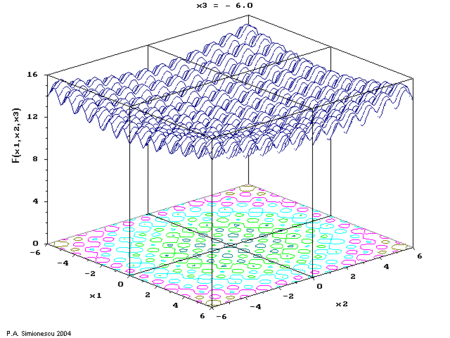.
Hyperplane
In geometry, a hypersurface is a generalization of the concept of hyperplane. Suppose an enveloping manifold M has n dimensions; then any submanifold of M of n − 1 dimensions is a hypersurface. Equivalently, the codimension of a hypersurface is one. For example, the n-sphere in Rn + 1 is called a hypersphere. Hypersurfaces occur frequently in multivariable calculus as level sets.

Ackley's function of three variables, with time the 3rd variable.
In Rn, every closed hypersurface is orientable.[1] Every connected compact hypersurface is a level set,[2] and separates Rn in two connected components,[2] which is related to the Jordan–Brouwer separation theorem.
In algebraic geometry, a hypersurface in projective space of dimension n is an algebraic set (algebraic variety) that is purely of dimension n − 1. It is then defined by a single equation f(x1,x2,...,xn) = 0, a homogeneous polynomial in the homogeneous coordinates.
Thus, it generalizes those algebraic curves f(x1,x2) = 0 (dimension one), and those algebraic surfaces f(x1,x2,x3) = 0 (dimension two), when they are defined by homogeneous polynomials.
A hypersurface may have singularities, so not a submanifold in the strict sense. "Primal" is an old term for an irreducible hypersurface.
See also
Affine sphere
Coble hypersurface
Polar hypersurface
Null hypersurface
Dwork family
References
Hans Samelson, "Orientability of hypersurfaces in Rn", Proceedings of the American Mathematical Society, Vol. 22, No. 1 (Jul., 1969), pp. 301-302.
Elon L. Lima, "The Jordan-Brouwer separation theorem for smooth hypersurfaces", The American Mathematical Monthly, Vol. 95, No. 1 (Jan., 1988), pp. 39-42.
Hazewinkel, Michiel, ed. (2001), "Hypersurface", Encyclopedia of Mathematics, Springer, ISBN 978-1-55608-010-4
Shoshichi Kobayashi and Katsumi Nomizu (1969), Foundations of Differential Geometry Vol II, Wiley Interscience
P.A. Simionescu & D. Beal (2004) Visualization of hypersurfaces and multivariable (objective ) functions by partial globalization, The Visual Computer 20(10):665–81.
Retrieved from "http://en.wikipedia.org/"
All text is available under the terms of the GNU Free Documentation License

